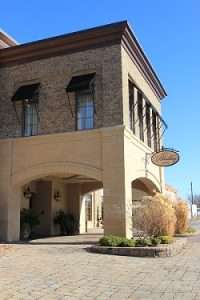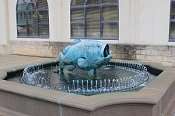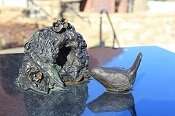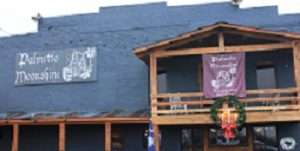
Jan 28, 2019 | Education, Human Potential, Staying on Top
by Sharon Purvis
One of Ten at the Top’s focus areas for 2019 will be convening various stakeholders to address what is becoming a serious problem in South Carolina: a shortage of teachers to meet the growing demand.
Working with Ten at the Top to spearhead this initiative is Ansel Sanders, president and CEO of Public Education Partners, whose mission is “to lead our community in acting collectively to support, strengthen and advance public education and student achievement in Greenville County Schools.” That mission positions Sanders ideally to gather interested parties to address the shortage.
student achievement in Greenville County Schools.” That mission positions Sanders ideally to gather interested parties to address the shortage.
Ten at the Top has for some time been convening district superintendents and business leaders in the Upstate, but it has been with a workforce development focus in the past. The group evolved to include leaders in higher education in an effort to bridge the gap between K-12 and higher education institutions.
After several meetings with representatives from those three sectors, it became clear that the state’s teacher shortage—which is only projected to worsen if steps are not taken to address it—is an issue that needs focused attention.
The problem is two-pronged: the over-all student population in South Carolina public schools has grown by an average of 7,400 students per year over the last 5 years, and higher turn-over and fewer teacher graduates means a diminishing supply of teachers to meet the demand. (For an in-depth analysis of the issue, click here.)
In an effort to get their arms around what is needed to tackle this issue, the group began by forming three committees to address the following:
- Understanding the challenge—why is there a shortage? What are teachers actually saying?
- Thinking about elevating the profession. How do we better tell the story of teachers? This a marketing strategy, both to potential teachers and the public.
- Thinking specifically about teacher retention and recruitment strategies.
 The first is important because, Sanders says, the shortage is really a symptom of an underlying problem, and without an understanding of what’s causing it, any measures taken to address it will be ineffective—or at least not as effective as they could be. Teacher pay gets a lot of press, but it is far from the only issue. Public perception of teachers and education is also a factor, as is a lack of stature for the profession, and the 2nd and 3rd committees seek to address those issues.
The first is important because, Sanders says, the shortage is really a symptom of an underlying problem, and without an understanding of what’s causing it, any measures taken to address it will be ineffective—or at least not as effective as they could be. Teacher pay gets a lot of press, but it is far from the only issue. Public perception of teachers and education is also a factor, as is a lack of stature for the profession, and the 2nd and 3rd committees seek to address those issues.
The key, says Sanders, is “how to elevate, modernize, and professionalize teaching.” What makes a profession a profession? Compensation is a piece of the puzzle, certainly, but it’s also training and the autonomy to do one’s job, as well as the respect that is afforded to other professions, Sanders says. He continues: “We respect them, but do we respect and honor them the way we do, say, our military, or other highly honored professions? Are we telling our own children that they should aspire to be teachers, or are we not?”
Alternate routes to certification are another piece of the puzzle—not to replace the traditional route through colleges of education, but to supplement it as a source of teachers. An added benefit of that is that the pool of teachers entering the profession will have added diversity, with older teachers who have had other professional experience to draw on.
The three committees are just underway and will meet in January and early February and will report to the larger group, called  the Education Spectrum Forum, in April. Each has 10-12 members, comprised of K-12, higher education, and business sectors. Although Sanders hopes to engage policymakers, the outcome of the committees is not policy recommendations, but the hope is that policy will emerge from the process.
the Education Spectrum Forum, in April. Each has 10-12 members, comprised of K-12, higher education, and business sectors. Although Sanders hopes to engage policymakers, the outcome of the committees is not policy recommendations, but the hope is that policy will emerge from the process.
This group’s efforts are running parallel to legislative efforts, in fact, with education being at the forefront of policy initiatives in Columbia. South Carolina Public Radio reports that Gov. McMaster’s budget recommendation calls for a 5% pay raise for teachers among other things as part of his promise to fix education in the state. The money to pay for the proposed reforms comes from a budget surplus as well as increased tax revenues from a growing economy. And McMaster promised in his State of the State address to sign into law reform bills that have been proposed in the state assembly.
Ten at the Top and Public Education Partners will continue to focus on this issue throughout 2019 and will continue to use this space to update constituents on the progress.

Jan 22, 2019 | Natural Resources, Staying on Top
by Sherry Jackson
Located near the town of Walhalla are two of Oconee County‘s top attractions, Stumphouse Tunnel and Issaqueena Falls. Stumphouse Tunnel maintains a near constant 56 degree temperature and is a welcome respite on a hot summer day. Nearby at Issaqueena Falls visitors can enjoy the waterfall and have a picnic at the shady retreat.
Stumphouse Tunnel
In 1852, this railroad tunnel was begun as part of a route that was to go from Charleston to Knoxville and eventually on to Cincinnati. Fifteen hundred workers, mostly Irish immigrants, worked twelve hours a day, six days a week using only sledge hammers, hand drills, and black powder to carve out the hard granite from Stumphouse Mountain. It’s been said that the Mountain defeated the Rail Line because in 1859 lack of funds interrupted construction and then the Civil War brought construction to a halt. There were various efforts by the Blue Ridge Railroad to revive the tunnel construction but it never came to fruition.
Cincinnati. Fifteen hundred workers, mostly Irish immigrants, worked twelve hours a day, six days a week using only sledge hammers, hand drills, and black powder to carve out the hard granite from Stumphouse Mountain. It’s been said that the Mountain defeated the Rail Line because in 1859 lack of funds interrupted construction and then the Civil War brought construction to a halt. There were various efforts by the Blue Ridge Railroad to revive the tunnel construction but it never came to fruition.
In the 1950s, a professor at Clemson University realized that the constant fifty-six degrees with 85% humidity conditions of the tunnel were ideal for making blue cheese. They used the tunnel to perfect the curing process for several years before it was moved back to the college.
Today the 1617 foot-long tunnel is one of the most visited sites in South Carolina. It’s considered somewhat of an oddity and a monument to pre-Civil War engineering. When visiting, be sure to take a flashlight as the tunnel is very dark, and don’t disturb the bats overhead. In recent years, there have been some falling rocks near the airshaft so a gate has been installed and you can only go about 50 yards into the tunnel.
Issaqueena Falls
 This waterfall is named for a Creek Indian maiden named Issaqueena who had been captured by the Cherokees. She met and fell in love with a white trader named Allan Francis. When she learned that the Cherokee were planning an attack on the fort where her beloved lived, she warned the white settlers. When the Cherokee came after her, Issaqueena saw them coming and, knowing that they believed evil spirits lived in waterfalls, she pretended to jump over the falls but instead she hid on a ledge behind the falls. She remained there until they were gone and it was safe, thus tricking her pursuers.
This waterfall is named for a Creek Indian maiden named Issaqueena who had been captured by the Cherokees. She met and fell in love with a white trader named Allan Francis. When she learned that the Cherokee were planning an attack on the fort where her beloved lived, she warned the white settlers. When the Cherokee came after her, Issaqueena saw them coming and, knowing that they believed evil spirits lived in waterfalls, she pretended to jump over the falls but instead she hid on a ledge behind the falls. She remained there until they were gone and it was safe, thus tricking her pursuers.
There is a short, easy walking trail that leads to an overlook where you can view the 200-foot cascading falls.
Blue Ridge Railroad Trail
If you’re feeling adventurous, the Blue Ridge Railroad Trail at Issaqueena Falls is one of the lesser trekked trails in Oconee County. It’s marked by a small sign and yellow trail blazers. The moderately strenuous trail is about 4.5 miles round trip and follows along the railroad grade approach to Stumphouse Tunnel. Be prepared with bug spray as some of the trail is a little overgrown and spiders and ticks are prevalent.
Stumphouse Tunnel and Issaqueena Falls are located about 7 miles Northwest of Walhalla on Highway 28.
The park is maintained by the City of Walhalla and is open daily from 10 a.m. until 5 p.m. except Christmas Day and inclement weather days.
Admission is free. There are outhouse restrooms and picnic tables.


Jan 16, 2019 | Uncategorized
by Sherry Jackson
Anderson grew up as a textile town. Several mills in the area provided the groundwork for a rich and vibrant city while still maintaining its rural roots. When Lake Hartwell was created in the 1950s, it brought those seeking boating and fishing along its 962-mile long shoreline.
Anderson is also commonly referred to as the “electric city” as it was the first city in the United States to have a continuous supply of electricity, powered by a water mill on the Rocky River. A statue of William Church Whitner, who devised a method to transport electricity from the river into the city, sits prominently in the downtown city square.
Today, Anderson’s downtown offers great dining, eclectic boutiques, museums, and cultural activities that are definitely worth exploring.

It all starts with a good night’s sleep
The Bleckley Inn, a 14-room boutique hotel, is top-notch and worthy of at least an overnight stay. Owners Steve and Lynn Kay,  who moved to downtown Anderson in 2006, have been, and continue to be, instrumental in the downtown’s redevelopment. After housing the Budweiser Clydesdales in their historic Carriage House stable, the Kays realized that there was a barn for the horses but nowhere in town for their caregivers to stay. In 2011, the Kays opened the Bleckley Inn, and the Carriage House now serves as the Inn’s event space where weddings and other events are hosted frequently.
who moved to downtown Anderson in 2006, have been, and continue to be, instrumental in the downtown’s redevelopment. After housing the Budweiser Clydesdales in their historic Carriage House stable, the Kays realized that there was a barn for the horses but nowhere in town for their caregivers to stay. In 2011, the Kays opened the Bleckley Inn, and the Carriage House now serves as the Inn’s event space where weddings and other events are hosted frequently.
Spa robes, luxurious linens, and clean and well-decorated rooms are all part of the luxury experience. Nightly milk and homemade cookies top it off, and the complimentary buffet breakfast shouldn’t be missed, with breakfast casseroles, candied bacon, and fresh fruit and pastries.
The inn also has an additional eight rooms with their own unique charm located on the downtown square and two fully furnished apartments available for short- and long-term rental.
Explore art in Anderson
As you stroll along the streets of downtown Anderson, be on the lookout for fish and wrens. Both are part of the city’s art in public spaces initiative. In fact, the city was awarded the 2013 Elizabeth O’Neill Verner Award, the governor’s award for public art and the highest award for art in the state.
 “Fish Out of Water“ features 35 large-mouth bass sculptures scattered throughout downtown as an ode to the indigenous species in nearby Lake Hartwell. The Wren Project is a special installation of 20 bronze wren sculptures hidden in the eaves of downtown buildings to provide “a bird’s eye view of downtown.“
“Fish Out of Water“ features 35 large-mouth bass sculptures scattered throughout downtown as an ode to the indigenous species in nearby Lake Hartwell. The Wren Project is a special installation of 20 bronze wren sculptures hidden in the eaves of downtown buildings to provide “a bird’s eye view of downtown.“
A 2013 vibrancy grant from Ten at the Top provided funds to wrap electrical boxes and paint  crosswalks with images from the book, Little Wren Lost and the Teakettle Call, a children’s book featuring original watercolors of icons across the state and in Anderson.
crosswalks with images from the book, Little Wren Lost and the Teakettle Call, a children’s book featuring original watercolors of icons across the state and in Anderson.
In the fall of 2013, Carolina Wren Park opened in the heart of downtown. The park provides an amphitheater with a stage, fountain, splash pad, and dancing lights. The venue is also home to “The Block Party” presented by Piedmont Natural Gas on Thursday nights from April to October, where thousands gather to hear local bands and enjoy time outside. On Friday and Saturday nights through December 20, children can delight in falling “snow” at the park.
Southern history lessons
Several historic buildings still stand in downtown Anderson, and a self-guided walking tour guide can be obtained from Visit Anderson. Learn about the Chiquola Hotel, constructed in 1888, now home to luxury condos. The circa-1891 Sullivan Hardware Store now serves as an upscale restaurant, aptly called Sullivan’s Metropolitan Grill.
For a deeper dive into Anderson’s history, stop by the Anderson County Museum. Displays include the history of the surrounding mill villages and what life was like in the rural county. See the impact that Duke Energy and Lake Hartwell had on the area. Admission to the museum is free.
Wet your whistle and grab some grub
A stop by Palmetto Moonshine will provide an opportunity to taste South Carolina’s first legal distillery and see how “white  lightning” is made. A large gift shop allows for plenty of souvenir shopping and to purchase a jar of your favorite flavor of “shine.”
lightning” is made. A large gift shop allows for plenty of souvenir shopping and to purchase a jar of your favorite flavor of “shine.”
Anderson also has many great dining choices. At Figs Beanery and Creamery you can get your daily java fix, a sweat treat, a scoop of ice cream, or even a sandwich. Located in an old bank building, Doolittle’s Restaurant, where the motto is “Eat. Drink. Do Little,” serves up fresh-made sandwiches, salads, and other specialties.
For dinner, Summa Joe’s is a farm-to-table restaurant offering fresh ingredients for dishes from pizzas, pastas, sandwiches, and other specialty dishes. If you’re looking for something a little more upscale, Sullivan’s Metropolitan Restaurant serves up steaks, duck, and fresh seafood.
Several boutique and antique shops line Main Street, and the city hosts special events throughout the year. So next time you’re trying to decide on what to do, go explore the Upstate’s own Electric City.

Jan 9, 2019 | Community Vibrancy, Staying on Top
by Sharon Purvis
Museums are a great way to learn about a small slice of history—and from trains to baseball to kitchen gadgets to Cherokee Nation history, there are some fascinating museums big and small in various corners of the Upstate that are worth checking out.
For art lovers, there are a few not-to-be-missed museums in the area, like the Greenville County Museum of Art, which has the largest collection of Andrew Wyeth watercolors of any public museum in the world; and the Spartanburg Art Museum at the Chapman Cultural Center in Spartanburg, whose current exhibit, In Their Element, explores the four basic elements—earth, fire, water, and air—as metaphors for life.
The Bob Jones University Museum and Gallery, whose collection includes 420 religious-themed paintings by masters such as Rubens, Botticelli, and Honthorst and more than 1,000 antiquities spanning 37 centuries, is currently closed for renovations, but there are still ways you can see parts of the collection in the meantime.
There are some quality county museums focusing on county-specific heritage and history, such as the Oconee History Museum , the Anderson County Museum, and the Cherokee County History and Arts Museum. The Union County Museum, the Museum and Railroad Historical Center in Greenwood, and the Greer Heritage Museum all chronicle local history through artifacts and photographs as well.
For kid-friendly museum exploration, visit the Spartanburg Science Center, full of interactive exhibits, live animals, bones and fossils, and educational displays, or the Children’s Museum of the Upstate—which has a second location in Spartanburg—where kids (and grown-ups) can explore art, music, water, movement, and more.
 And, of course, there are plantations and historic homes that preserve history so visitors can step back in time: the Burt-Stark Mansion in Abbeville, Ashtabula and Woodburn Historic Homes in Pendleton (closed for the winter currently, but private tours may be arranged), Oconee Station Historic Site, the Hanover House in Pickens, Rose Hill Plantation State Historic Site in Union, and Walnut Grove Plantation in Spartanburg.
And, of course, there are plantations and historic homes that preserve history so visitors can step back in time: the Burt-Stark Mansion in Abbeville, Ashtabula and Woodburn Historic Homes in Pendleton (closed for the winter currently, but private tours may be arranged), Oconee Station Historic Site, the Hanover House in Pickens, Rose Hill Plantation State Historic Site in Union, and Walnut Grove Plantation in Spartanburg.
Even if you’re aware of all of those museums, here are some smaller niche museums you may have missed:
- Museum of the Cherokee in South Carolina: a tribute to Cherokee history and culture (Walhalla, SC; open Thursday–Saturday 11:00 a.m.–4:00 p.m.)
- General Store Museum: a recreation of England’s General Merchandise store, with genuine historic artifacts (127 E. Main Street, Westminster, SC; open Thursday–Saturday 11:00 a.m.–4:00 p.m.)
- Bob Campbell Geology Museum: more than 10,000 rocks, minerals, and fossils plus paleontological exhibits (140 Discovery Lane, Clemson, SC; open Monday–Sunday, 10 a.m.–5 p.m.)

- Hub City Railroad Museum: housed in the depot building, displays include railroad artifacts as well as items that would have been shipped by railroad (298 Magnolia Street, Spartanburg, SC; open Wednesday and Saturday, 10 a.m.–2 p.m.)
- Miller Bible Museum at North Greenville University: A collection of rare printed Bibles, including a tiny Bible only an inch and a half tall (7801 N. Tigerville Road, Tigerville, SC; call 864-977-7091 for hours)
- The Historic Belton Train Depot houses two different museums: The Ruth Drake Museum’s holdings include all kinds of artifacts of domestic life, from kitchen gadgets to farm implements, and the South Carolina Tennis Hall of Fame includes portraits of inductees, and plenty of other tennis memorabilia. (100 N. Main Street, Belton, SC; open Wednesday–Saturday; call 864-338-7400 for hours)


Jan 2, 2019 | Community Vibrancy, Economic & Entrepreneurial Vitality, Staying on Top
by Sharon Purvis
Spartanburg’s Chamber of Commerce is serious about supporting its local businesses, creating the Spartanbucks program to encourage spending in the community. So far, 24 local merchants have signed on to the program, and $40,000 worth of Spartanbucks have been purchased—with that much more pledged to be purchased between five different companies.
While individuals have purchased Spartanbucks in the form of gift cards, the bulk of what has been purchased and committed  has come from corporations for employee gifts and bonuses. Just as important, though, is getting merchants to sign on so that recipients have a number of options to choose from in spending their bucks.
has come from corporations for employee gifts and bonuses. Just as important, though, is getting merchants to sign on so that recipients have a number of options to choose from in spending their bucks.
Shauna Axelrod, executive assistant at the Spartanburg Chamber and Spartanbucks point person, says, “As we grow this, it’s ideal that we grow both merchants and employers. We’d like to make it as big as possible, and at the end of the day, it’s just putting a lot of money back into the community, which is great.”
Right now, in the beginning stages of the program, the participating merchants are almost all in the downtown area, but Axelrod says she hopes as the program grows, merchants across the county will participate as well.
Many of the merchants are restaurants, but Spartanbucks can also be spent at the Chapman Cultural Center and the Children’s Museum of the Upstate, as well as at local retail stores.
How It Works
Spartanbucks gift certificates may be purchased through the Spartanburg Chamber web site or by clicking here.
Recipients will get a link sent either to their phone or their email, and that link will contain the list of participating merchants. With the link, they’ll have either a printed gift certificate or an electronic one on their phone, and that gives the merchant a credit card number to run.
 On the merchant side, the credit card number is sent to the store via a link, and once a ten-cent transaction is run using the number, they are set up with the Spartanburg Chamber as a participating merchant—so customers can’t simply use that credit card number at Wal-mart or another non-participating store.
On the merchant side, the credit card number is sent to the store via a link, and once a ten-cent transaction is run using the number, they are set up with the Spartanburg Chamber as a participating merchant—so customers can’t simply use that credit card number at Wal-mart or another non-participating store.
For level 1 chamber members, the cost is $100 per year; for those at level 2 and above, it is complimentary as part of their chamber investment. Non-members may also participate for an annual fee of $250.
The back end of the program is run through a company called Yiftee, which provides Local First gift card services for any community that wants to commit to keeping money local, supporting local businesses. There is a per-merchant fee, and Yiftee requires 12 participating merchants to set up the program. The Spartanbucks program is a simple one, with no physical cards, but branded merchant cards are available through Yiftee for a monthly fee.
To become a participating merchant or to find out more about using Spartanbucks as an employee reward system, contact Shauna Axelrod at (864) 594-5011 or email her at saxelrod@spartanburgchamber.com.

 student achievement in Greenville County Schools.” That mission positions Sanders ideally to gather interested parties to address the shortage.
student achievement in Greenville County Schools.” That mission positions Sanders ideally to gather interested parties to address the shortage. The first is important because, Sanders says, the shortage is really a symptom of an underlying problem, and without an understanding of what’s causing it, any measures taken to address it will be ineffective—or at least not as effective as they could be. Teacher pay gets a lot of press, but it is far from the only issue. Public perception of teachers and education is also a factor, as is a lack of stature for the profession, and the 2nd and 3rd committees seek to address those issues.
The first is important because, Sanders says, the shortage is really a symptom of an underlying problem, and without an understanding of what’s causing it, any measures taken to address it will be ineffective—or at least not as effective as they could be. Teacher pay gets a lot of press, but it is far from the only issue. Public perception of teachers and education is also a factor, as is a lack of stature for the profession, and the 2nd and 3rd committees seek to address those issues. the Education Spectrum Forum, in April. Each has 10-12 members, comprised of K-12, higher education, and business sectors. Although Sanders hopes to engage policymakers, the outcome of the committees is not policy recommendations, but the hope is that policy will emerge from the process.
the Education Spectrum Forum, in April. Each has 10-12 members, comprised of K-12, higher education, and business sectors. Although Sanders hopes to engage policymakers, the outcome of the committees is not policy recommendations, but the hope is that policy will emerge from the process.

 This
This 

 who moved to downtown Anderson in 2006, have been, and continue to be, instrumental in the downtown’s redevelopment. After housing the Budweiser Clydesdales in their historic Carriage House stable, the Kays realized that there was a barn for the horses but nowhere in town for their caregivers to stay. In 2011, the Kays opened the Bleckley Inn, and the Carriage House now serves as the Inn’s event space where weddings and other events are hosted frequently.
who moved to downtown Anderson in 2006, have been, and continue to be, instrumental in the downtown’s redevelopment. After housing the Budweiser Clydesdales in their historic Carriage House stable, the Kays realized that there was a barn for the horses but nowhere in town for their caregivers to stay. In 2011, the Kays opened the Bleckley Inn, and the Carriage House now serves as the Inn’s event space where weddings and other events are hosted frequently. “Fish Out of Water
“Fish Out of Water crosswalks with images from the book,
crosswalks with images from the book,  lightning” is made. A large gift shop allows for plenty of souvenir shopping and to purchase a jar of your favorite flavor of “shine.”
lightning” is made. A large gift shop allows for plenty of souvenir shopping and to purchase a jar of your favorite flavor of “shine.”
 And, of course, there are plantations and historic homes that preserve history so visitors can step back in time: the
And, of course, there are plantations and historic homes that preserve history so visitors can step back in time: the 


 On the merchant side, the credit card number is sent to the store via a link, and once a ten-cent transaction is run using the number, they are set up with the Spartanburg Chamber as a participating merchant—so customers can’t simply use that credit card number at Wal-mart or another non-participating store.
On the merchant side, the credit card number is sent to the store via a link, and once a ten-cent transaction is run using the number, they are set up with the Spartanburg Chamber as a participating merchant—so customers can’t simply use that credit card number at Wal-mart or another non-participating store.